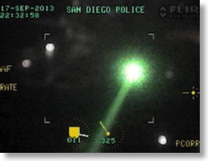Home
A comprehensive resource for safe and responsible laser use
US: Man aimed laser at police helicopter during Detroit protest
The protesters were from the group Detroit Will Breathe, self-described as "an integrated, youth-led, militant organization fighting against police brutality and systemic racism in Detroit." During a march, at about 12:30 am, the helicopter was illuminated intermittently for about seven seconds by a laser. The pilot later told investigators that "the green laser beam resulted in temporary momentary blindness causing the incapacitation of the flight crew."
Video from the helicopter, a city bus, and local buildings led investigators to Michael Sam Hurd of Fennville, Michigan. In November 2020 federal agents raided Hurd's home. He admitted having a laser pointer.
On May 14 2021 he was charged with a federal felony with a maximum five years of prison time, and was released on $10,000 bail.
After the hearing, Hurd's lawyer said "This happened in the context of a Black Lives Matter demonstration going on, so it is not like it took place at an airport or anything…. This was during the protest march when there was excessive brutality done by the police force. Whatever actions on the part of my client — we are still trying to get to the bottom of it — I’m sure were done in defense of others.”
From the Detroit News and Fox 2 Detroit. The Detroit News article has many helicopter and surveillance photos of the incident.
Australia: NSW Police Force warns during "spike" in laser pointer strikes
PolAir warns about dangers of aiming laser pointers at aircraft after recent strikes
The NSW Police Force Aviation Command is warning the community about the dangers of aiming laser pointers at aircraft after a spike in recent incidents, one involving an officer whose vision was allegedly temporarily impaired.
The Command has recorded about a dozen incidents of laser pointers being aimed at their aircraft and other aircraft flying around Sydney in recent weeks.
Click to read more...
US: FBI offers $2,500 reward for arrest of person aiming a laser at an Air Force aircraft
The aircraft was on approach to Savannah Air National Guard Base when it was "deliberately struck by a high-powered laser for about one minute" according to the FBI. A crew member had temporary eye damage from the laser strike.
Anyone with information about the March 9 laser strike is asked to contact FBI Atlanta at 770-216-3000 or go to tips. fbi.gov.
From Military.com,The Advance, and the Associated Press
UK: "Prolonged laser strike" on police helicopter over Derby
Derbyshire police officers were sent to an address to speak to the persons involved. There was no word of an arrest.
From Derbyshire Live
US: Crew member seeks medical help after laser aimed at Customs helicopter
The helicopter had been doing training approaches to Bellingham International Airport when the cockpit was illuminated. Deputies on the ground located 34-year-old Ronald Gregory Boettcher. He said he did not have a laser and did not aim a laser at an aircraft. Deputies found he did have a laser pointer. He was arrested on suspicion of unlawful discharge of a laser.
The CBP agent's medical condition and prognosis was not available.
From The Columbian and TickleTheWire.com
US: Colorado group says crew member lost vision permanently after 2017 laser strike
This was echoed in a TV report on KRDO, where a registered nurse said "In 2017, we had a crew member hit with a laser, he lost 30% of his vision in his right eye, and that was permanent damage." Another nurse told the TV reporter that after a laser illumination, "I lost my vision for a few minutes due to black circles. And then I had about a three to seven day [period] of almost just sand and painful vision for a few days."
No further details were given in the news reports. On March 1, LaserPointerSafety.com reached out to Flight for Life for more information.
Both accounts described how Flight For Life helicopter crews in Southern Colorado have been subjected to laser illuminations that have been recently increasing.
In both accounts a crew member described the light as being similar to directly looking at a camera flash. According to the Pueblo Chieftain article, "Several Flight For Life members across Colorado have had to take time off in the past to allow their eyes to heal after a laser strike."
From the Pueblo Chieftain and KDRO
US: Florida man arrested for aiming laser at sheriff's helicopter; pilot gets medical treatment
The pilot was able to direct ground officer's to the laser's location. Jason Ogle had a laser in his hand but threw it inside a house's doorway as deputies approached.
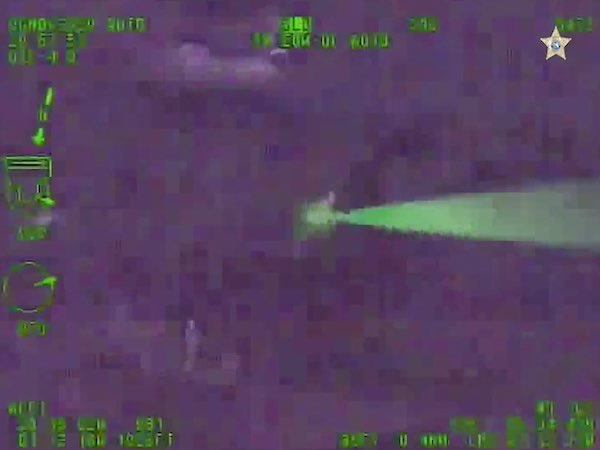
Screenshot from Sheriff's Office video. Jason Ogle's body and head is the gray blob above the beam location in the middle of the screen.
Ogle was charged with pointing a laser light at a driver or pilot.
The pilot sought medical treatment for unspecified issues with his eyes.
From ClickOrlando.com. Video from the helicopter is available on the web page.
US: Two separate arrests for aiming laser at sheriff's helicopter; in one, pilot blinded for 3-5 minutes
On September 22 2020, 29-year-old Ryan Hutton was arrested for aiming a green laser pointer at the helicopter while he was on a boat. The helicopter had been on a burglary call. The pilot's vision in his right eye was affected for about three to five minutes "like a flashbulb going off in front of his eye" according to a news story.
Hutton told arresting officers he thought the helicopter was a drone.
A day later, 60-year-old Gregory Marr aimed at the Sheriff's Office helicopter while they were conducting a search. Officers from nearby Flagler County were directed to Marr's home.

Gregory Marr
Both men were charged with pointing a laser at a driver or pilot.
From ClickOrlando.com
Canada: Passenger plane pilot said to have eye injuries near Ottawa
He was said to have received injuries to his eyes; the nature and severity of the injuries were not reported.
Transport Canada opened an investigation into the incident.
From AeroTime News Hub, official CADORS report. See also Canadian airline pilots' March 11 2020 reaction to this and other laser incidents.
Canada: Pilot and paramedic have unspecified eye injuries from laser aimed at medical aircraft
On February 15, 2020 at approximately 8:50 p.m., an Ornge aircraft was struck by a green laser in the area of Richmond and Sherbourne Street in the downtown Toronto area. The aircraft was on route back to base at Billy Bishop Airport after completing a call to The Hospital for Sick Children in Toronto. The aircraft returned to base without further incident. A report was filed with Toronto Police for investigation as well as a Directed Bright Light Illumination Report with Transport Canada.
As a result of the strike, an Ornge pilot and paramedic sustained an eye injury and required evaluation from a physician at a local Toronto hospital.
A video of the strike was captured by the flight crew and provided to Toronto Police.
Pointing lasers at aircraft can:
- Distract pilots
- Cause temporary or permanent blindness
- Create a glare in the cockpit affecting pilot vision
- Cause further injury to Ornge patients
- Distract or injure Ornge paramedic
Under the Aeronautics Act, if an individual is convicted of pointing a laser at an aircraft, they could face up to:
- $100,000 in fines
- 5 years in prison
- Or both
Ornge encourages anyone who witnessed this incident to contact Toronto Police and Transport Canada. Anyone witnessing lasers being pointed towards aircraft can contact their local police or Transport Canada.
In 2019, Ornge had three reported laser strikes on our aircraft. In 2020, there have been five reported laser strikes on our aircraft.
For more information about laser strikes, feel free to visit this Laser Strike Campaign page by Transport Canada.
From an Ornge press release. No further information on the status of the pilot and paramedic was available.
UK: Pilot said to have laser burn in eye
According to the Oxford Mail, "the extent of his injury is unknown at this time [Feb. 19], although it is expected he will make a full recovery and return to training."
The next night, another training aircraft was hit by a laser in the same general area. No injury was reported.
An investigating Thames Valley Police officer said "The trainee pilot of the first aircraft suffered injuries to the back of his eye as a result of this attack and the injuries may result in him being unable to fulfill a career in aviation. The recklessness of such acts not only endangers the aircraft and all passengers on board, but also those on the ground, as attacks such as this seriously jeopardize safety."
Police were asking anyone with information to contact them.
From the Oxford Mail
UPDATE: According to a February 25 2020 article in the Evening Standard, "Due to the nature of the injuries he is currently unable to fly." The article also described an incident where a green laser was aimed at an RAF C-17 cargo plane near RAF Brize Norton in Oxfordshire, on February 22 2020. This is roughly the same area as where the two training flights were illuminated on February 4 and 5.
US: Pilot has eye problems after laser aimed at California police aircraft
CHP pilot Jan Sears was directly illuminated by the blue laser beam. He later described the effect: "So it's pitch black and we're flying and all of a sudden it's like the sun just came out. It took me a minute to get my bearings…." Sears was able to control the aircraft by activating the autopilot. The CHP flight officer directed deputies on the ground to the suspect's location.
He was identified as Christopher Larsen, 33. He was charged with two state felonies for discharging a laser and aiming a laser at an aircraft, and may also be charged with a federal felony.

Christopher Larsen
Sears said Larsen was "using a laser that's illegal, much more expensive and highly powerful." He noted that "In a week we are lased once maybe twice; sometimes we catch them, sometimes we don't."

A laser similar in design to the one Larson was found with
Sears told NBC Bay Area that he was "still having residual effects with my left eye. I feel that something has happened." He said he had experience with green lasers before, but "this was a blue laser. It was the worst type to get involved with." Protective eyewear was on board, but it was intended to reduce green light, not blue.
From CBS San Francisco Bay Area, GoodDay Sacramento, KSRO and NBC Bay Area
Commentary from LaserPointerSafety.com: Most lasing incidents involve green light, so glasses that reduce the intensity of green light can be useful. Glasses are available which reduce green and blue — and even green, blue and red. However, the more wavelengths of light that the glasses attenuate, the more overall light is also dimmed. Plus this can make it more difficult to differentiate colors on the aircraft instrument panel. More information is on the page about laser glare protection eyewear.
US: Florida man shot with taser after aiming laser at aircraft and police helicopter
On January 22 2020, a man in an industrial area aimed a green laser pointer at aircraft near Sarasota-Bradenton International Airport, including a United Airbus A320 and Cessna Skyhawk planes that were practicing takeoffs and landings. Most reports said four aircraft were targeted, although airport police quoted in one story said only two airplanes were struck. The same story indicated it was the Cessna student pilot who reported eyesight problems.
A Manatee County Sheriff's Office helicopter was sent to investigate. The man aimed his laser at the helicopter as well as throwing objects towards it. The crew was able to pinpoint his location, about a quarter mile from the runway approach.
When deputies arrived on the scene, they found 41-year-old Charlie James Chapman Jr. He was on a forklift, and made a "striking motion" with a hammer towards the officers. They used a Taser two times to subdue Chapman. A laser pointer was found in his pants pocket. He was taken to a hospital, and later to jail.

Charlie James Chapman Jr.
Chapman was charged with aggravated assault on an officer, pointing a laser at a pilot with injury, pointing a laser at a pilot without injury and resisting without violence.
The sheriff's office released video from the helicopter:
Some stills from the video:
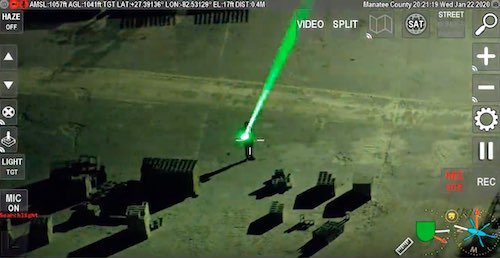
The laser is aimed towards the helicopter.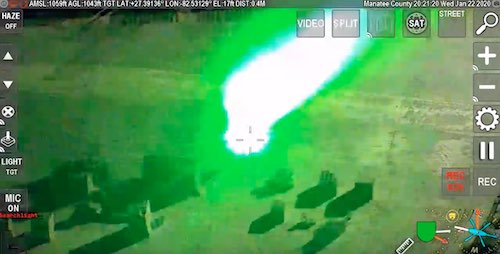
An almost direct hit on the camera lens.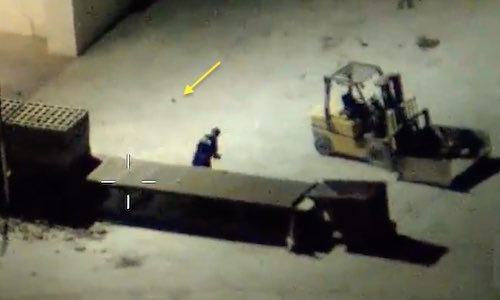
The man throws a small object (arrow) towards the helicopter — not reaching it, of course. The forklift can be seen on the right.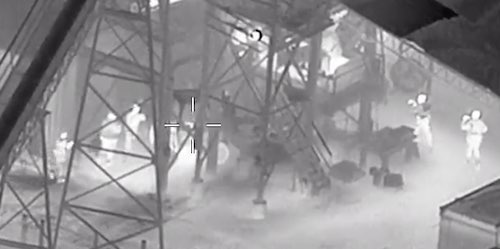
In an infrared view, officers (white shapes) move in to confront the perpetrator.
Chapman was apprehended at 8224 25th Court East in Sarasota, which is the worksite of Vulcan Materials Co., a ready-mix concrete supplier according to Google Maps.
From the Manatee County Sheriff's Office press release, the Orlando Sentinel via MSN, WRCBTV.com, ABC13.com, the Washington Post, WCTV, USA Today, and many other news sources and services. Thanks to Greg Makhov, Jack Dunn and Donna Colona for also bringing this to our attention.
US: WestJet pilot is said to have eyes "burned" at 10,000 feet
The flight continued to Orlando's airport and landed about 15 minutes after the incident.
At FAA's request, the Volusia County Sheriff's Office was asked to investigate a possible location for the laser. Deputies found a house with a bright green porch light, but the residents said they did not own a laser pointer.
The pilot was referred for medical examination, as per WestJet's standard operating procedure.
WestJet released a statement: "Laser incidents pose a serious concern to crew and aircraft safety and have serious repercussions for those found to be shining lasers in a manner that could result in injury or damage. These incidents are reported immediately to local authorities for further investigation. Pilots are extremely focused during all phases of flight, but especially during take-off and landing, when most laser incidents occur. When any sort of light enters the flight deck, pilots are trained to look away and maintain focus but they must also maintain vigilant with respect to their surroundings and monitor the apron prior to landing. Pilots take on an incredible responsibility controlling an aircraft, and it is WestJet’s duty to ensure a safe work environment for them to operate in. Any pilot who reports being struck by a laser is required for safety and health reasons to have an ophthalmology evaluation."
From the Aviation Voice, WESH.com, News965.com, and ClickOrlando.com
COMMENTARY FROM LASERPOINTERSAFETY.COM
It is almost a certainty that the pilot's eyes were not burned by the laser exposure. A laser beam that traveled 10,000 feet would have to be extraordinarily powerful to even potentially cause an eye injury.
Laser beams spread out with distance. At 10,000 feet a laser beam would expand to be at least three feet wide. Only a fraction of the beam power would go through the pupil of the pilot's eye. (In fact, of the original laser irradiance, only 0.003 percent would go through the pilot's pupil.)
What power would it take? A 190 watt laser with a very narrow 1 milliradian beam has a Nominal Ocular Hazard Distance of about 10,000 feet. This means the laser light is generally considered safe after the NOHD distance. This does not mean that just inside the NOHD there would be an injury. Laser safety standards have a built in "safety factor" or "reduction factor."
To have a 50/50 chance of causing the smallest medically detectable eye injury at a distance of 10,000 feet, the laser would have to be about 1,900 watts at a 1 mrad divergence.
By comparison, the most powerful handheld lasers currently available are in the 3 watt range with claimed wattage (not confirmed) up to about 6 watts. Most laser pointers used in incidents are less than 1 watt.
It may be that someone aimed a non-handheld, plug-in-the-wall laser beam at the pilot. Even here, 190 to 1,900 watts is fairly powerful. There are some industrial and research lasers much more powerful than this, but to the best of our knowledge the only non-handheld lasers involved in aircraft lasings have been from laser light shows. For such shows, 60 to 80 watts is about the most powerful from a single laser source. There were no reported outdoor laser light shows the night of the WestJet incident.
Some news articles gave an impression that, because the pilot's eyes were burned, he or she went for a medical examination. But as explained above, this is routine policy. WestJet requires "any pilot who reports being struck by a laser … to have an ophthalmology evaluation."
It could be that the pilot had an eye effect, such as irritation from the bright flash of light, or that the pilot rubbed his or her eyes so hard that they scratched their cornea — a painful condition which heals.
For more information
More information about laser eye effects on pilots is here. A quick summary is that 1) there have been no proven or documented eye injuries to pilots according to U.S. FAA, U.K. CAA and Transport Canada, and 2) top laser safety experts have written that "There is no evidence to suggest that lasers pointed at airplane cockpits damage pilots’ eyesight."
A table listing eye effects and incidents reported to U.S. FAA in past years is on the laser/aircraft illumination statistics page.
US: San Antonio man arrested for aiming laser at helicopter; pilot sees spots
Justin Shorey, 37, was arrested and charged with a Class A misdemeanor.
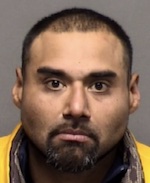
Justin Shorey
According to Fox News, in San Antonio there were 48 reports of lasers pointed at aircraft in 2016, 62 reports in 2017, and 74 reports from January through November 2018.
From Fox San Antonio. Thanks to Peter Smith and Leon McLin for bringing this to our attention.
UPDATE NOVEMBER 9 2020: Justin Shorey was sentenced to 51 months — over four years — in federal prison. After his term is complete, he will be placed on supervised release for an additional three years. From MySA.com. Details on his arrest, charges and sentencing are in the press release below from the U.S. Attorney's Office for the Western District of Texas.
Schertz Man Sentenced to Federal Prison for Pointing Laser at San Antonio Police Helicopter
In San Antonio today, a federal judge sentenced 39-year-old Justin John Shorey of Schertz, TX, to 51 months in federal prison after he pleaded guilty to aiming a laser pointer at a San Antonio Police Department helicopter, announced U.S. Attorney Gregg N. Sofer, FBI Special Agent in Charge Christopher Combs, San Antonio Division, and San Antonio Police Chief William McManus.
In addition to the prison term, U.S. District Judge David A. Ezra ordered that Shorey be placed on supervised release for a period of three years after completing his prison term.Click to read more...
US: Texas police pilot has pain in eyes for two days after laser is aimed at his helicopter
Ground officers arrested 42-year-old Sherryol Elton Clack, Jr. with a green laser pointer.
Two weeks later, FBI agents interviewed Clack. He said his friend had purchased the laser pointer and claimed the light could reach the moon. Clack then decided to aim it at a helicopter. He said this was done out of "stupidity" and he did not intend to harm anyone.
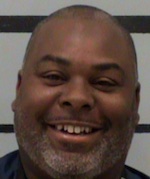
Sherryol Elton Clack, Jr.
On February 15 2019 Clack took a plea deal for the offense of Aiming a Laser Pointer at an Aircraft. Details of the deal were not available. If the judge approves the plea deal, Clack will be sentenced later to a term of up to five years in prison.
From EverythingLubbock.com
US: Jury deadlocked on case of laser aimed at police helicopter
On March 20 2018 a police helicopter was illuminated by a purple laser beam for about one minute. The pilot had eye irritation and put on night vision goggles. Silva, 33, was located on Fiesta Island and was arrested.
At trial, Silva told the jury he thought he was aiming at a drone piloted by a friend, and stopped when he realized he was instead aiming at a helicopter.
Prosecutors pointed out the difference between the helicopter and a drone, saying "He knew what he was doing. It was intentional. He didn't think he'd get found."
Silva's attorney noted that the helicopter was four miles away and thus looked smaller. She said "malicious intent" was required to convict, and that Silva did not have any intent to harm. She said "he profusely and repeatedly apologized" to police during his arrest, and that police did not go to look for the drone operator.
The jury deadlocked after four hours of deliberation on January 16 2019. Nine jurors voted to acquit and the remaining three jurors voted to convict.
The judge declared a mistrial and ordered Silva to return in late January to schedule dates for a possible re-trial. Silva remains free on $25,000 bond.
From sdnews.com
US: Kansas City woman arrested for aiming laser at police helicopter
The pilot was temporarily disoriented. He put on night vision goggles to prevent laser light from directly entering his eyes. He was able to direct officers on the ground to the woman, who was inside a car with a “long black cylinder-shaped laser pointer in her hand.”
Federal charges were filed against the 31-year-old woman.
According to KSHB, “Kansas City Police said the pilot flying the KCPD helicopter last month [May 2018] had a temporary deficiency in his vision and is currently recovering. The pilot is expected to return and fly again.”
The FBI said there were 110 cases of pilots reporting laser illuminations in Kansas City during 2017.
In January 2017, Jordan Clarence Rogers was sentenced to three years in federal prison for an October 2013 incident where he aimed a laser at a Kansas City police helicopter multiple times, resulting in several hours of eye strain for the pilot.
From June 1 2018 reports in the Kansas City Star, KSHB.com and Fox4KC.com
US: Student lands safely despite windscreen blocked by oil
A substance appearing to be oil coated the Cessna 172’s windscreen. The unnamed student said “I literally can’t see a thing” to flight controllers who safely talked him down. The incident lasted about 7 1/2 minutes.
Air traffic controller Tim Martin, who helped the student, said “That’s probably like a worst-case scenario for that pilot to land that plane with zero visibility.”
A spokesperson at at the student’s school, Embry Riddle Aeronautical University, said “the student-pilot did exactly what he had been trained to do.”
From the Daytona Beach News-Journal. Although this incident does not involve a laser, it does involve a pilot with no forward vision undertaking a landing, and thus may be relevant to pilots who are temporarily blinded by a dazzling laser beam exposure.
China: Pentagon made "groundless accusations" about Djibouti lasers
According to China Daily, “The Defense Ministry said in a statement that the ministry has dismissed such ungrounded accusations from some US officials via official channels. It added that China always firmly honors international laws and regulations in Djibouti, and is dedicated to safeguarding regional security and peace.”
Separately, Reuters reported that “Chinese Foreign Ministry spokeswoman Hua Chunying said the government had conducted ‘serious checks’ and told the U.S. side the accusations were groundless. ‘You can remind the relevant U.S. person to keep in mind the truthfulness of what they say, and to not swiftly speculate or make accusations,’ she told a daily briefing in Beijing.”
From China Daily and Reuters
US & Djibouti: UPDATED - Pentagon says Chinese have aimed lasers at US planes in Djibouti, causing two injuries
Spokesperson Dana White said the reason for the laser activity is unknown, “but it’s serious, we take it seriously.” She said it was “a true threat to our airmen”. The U.S. has protested and has asked the Chinese government to investigate.
Another Pentagon spokesperson, Major Sheryll Klinke, said the C-130 pilots were hit with a “military grade” laser.
On April 14 2018, the US military posted this notice to airmen (NOTAM) on the Federal Aviation Administration website, warning about “unauthorized laser activity” in Djibouti.

The NOTAM was scheduled to expire on June 14.
The NOTAM coordinates (N1135.70 E04303.14) are about 2,400 feet from China’s military base in Djibouti, opened August 1 2017 near Camp Lemonnier.
An article in the quasi-official South China Morning Post referred to “Chinese military observers [who] said the lasers might have been used to scare off birds near the airfield or disrupt possible spy drones, rather than targeting foreign pilots. A Beijing-based military analyst said China has already demonstrated laser weapons being used against drones, at airshows.
China is a signatory to the Protocol on Blinding Laser Weapons, which bans the use of lasers that cause permanent blindness. The protocol does not ban laser dazzlers, which temporarily impair vision but do not cause eye damage. It is also permitted under the Protocol to use lasers to disrupt or damage cameras and sensors such as those on missiles or satellites.
According to The Drive, “As of 2015, Chinese forces had access to at least four different man-portable systems, the BBQ-905, PY131A, PY132A, and the WJG-2002, all of which look like oversized assault rifles or shoulder-fired grenade launchers.”
From The Drive, Janes 360, C4ISRNET, Defense News, South China Morning Post, FAA PilotWeb, and a YouTube video of the May 3 2018 Pentagon press briefing by Dana White. Thanks to Greg Makhov for bringing this to our attention.
UPDATED May 4 2018: China’s Defense Ministry and Foreign Ministry both denied the U.S. allegations of laser use by China.
UPDATED May 7 2019: An annual report to Congress on Chinese military and security developments does not mention the April 2018 Djibouti laser incidents. It does mention "a few provocative Chinese military actions" but not the alleged Chinese lasers in Djibouti. A news story says the omission is "an apparent bid to preserve the controversial military exchange program with Beijing." From the Washington Free Beacon
US: Eye damage to Coast Guard crewmember
He and two other members of the MH-65 Dolphin helicopter crew landed safely after being hit by a laser several times at about 9 p.m. March 21 2018.
The aircrew conducted visual acuity tests with the duty corpsman. After consultation with the flight surgeon, two of the three aircrew members were medically grounded until they received further examination by an optometrist.
One of the crew members was found to have suffered eye damage and was grounded for seven days. The crew member will be reevaluated this week. The other crew member was grounded for two hours but has since returned to duty.
Because members of the crew were medically grounded, Naval Air Station Whidbey Island and Sector Columbia River in Warrenton, Ore., became responsible for covering the Port Angeles station’s area of responsibility until Port Angeles aircrews were medically cleared.
From the Peninsula Daily News and a U.S. Coast Guard press release
Canada: Pilot has blurred vision after green laser strike
The Airbus A319 had 113 passengers onboard when the incident occurred in November 2017. The captain was able to safely land the aircraft.
The report said that several other aircraft also reported laser light at the same point in their approach, for two nights in a row. The light was reported to be coming from persons in a park.
From mid-November to December 6 2017, there were 23 laser illuminations of commercial aircraft in the Toronto area. Nationwide, there were 381 laser strikes as of the first week of December 2017, down from the approximately 600 incidents reported in 2015 and 2016.
From The Star
US: Man aims laser from car at police helicopter, evades arrest, crashes
At about 12:45 am on October 22 2017, the helicopter was providing support to ground units responding to a domestic violence disturbance when it was continuously illuminated by a green laser beam. The tactical flight officer was hit three times in the eyes.
The pilot had momentary flashblindness and lost night vision. The tactical flight officer had watering eyes, discomfort and pain. There was no reported eye injury.
The helicopter broke off from its mission to pursue the laser perpetrator.
The beam came from the driver’s side of a car traveling north on Highway 99 in Fresno. Ground officers pursued Alvarez’s car, which began a high-speed chase. Twice during the chase Alvarez stopped to drop off passengers. The car eventually crashed into a median. Alvarez got out and ran towards neighboring homes. He was apprehended by officers in the backyard of a home after a short foot pursuit.
Alvarez had minor injuries from the crash and was taken to a hospital for treatment. At the hospital, a baggie was found with substances suspected to be marijuana, cocaine and methamphetamine.
Inside the car’s driver side door pocket police found a laser marked “Laser 303” with a green multi-dot beam (perhaps a diffraction grating making a star-field-like pattern) and a danger label.
After an FBI investigation, Alvarez was charged with violating federal law by knowingly aiming the beam of a laser pointer at an aircraft or its flight path. In addition, there were two previous felony warrants out for Alvarez’s arrest on other, unspecified charges.
From a report by Cyrus Farivar of Ars Technica. The criminal complaint filed in the U.S. District Court for the Eastern District of California is here.
UPDATED May 7 2018 — Michael Vincent Alvarez was sentenced to 18 months in prison for the October 22 2017 incident. From KMPH and the Fresno Bee.
US: Crew member has partial vision loss from laser illumination
Respiratory therapist Justin Misuraca was sitting in the co-pilot’s seat of a Flight for Life plane, helping the pilot watch for other air traffic, when a bright green light filled his vision. He closed his eyes and looked away; when he opened his eyes he was blinded for a few seconds.
A few days later he saw an eye specialist. Misuraca said the specialist told him “…there was a burn all the way to the back of my eye, and I’m missing 30 percent of my vision in an upside-down V.” He was told the burn was “half a millimeter from my optic nerve.”
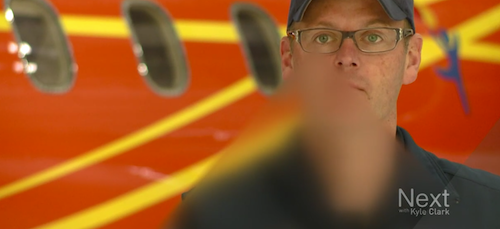
This screenshot from the KUSA 9news segment “Next” shows Justin Misuraca with a triangular blur overlay that the program says represents the visual effect of the laser injury. The area is highlighted below between the green lines to better define the area.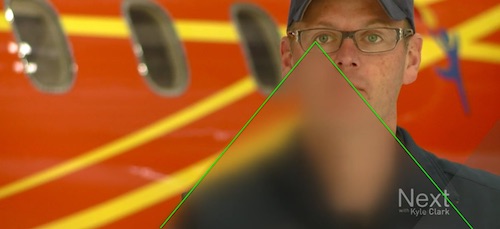
Misuraca reported this in an October 25 2017 interview with a reporter, so the vision loss was still present over a month after the laser illumination.
The pilot on the September 15 flight also reported temporary blindness but has no permanent injury.
According to Flight for Life, there have been “at least a dozen times in the last couple of years” that the organization’s aircraft have been targeted by a laser beam. The source of the September 15 laser illumination is unknown.
From October 25 and October 26 reports by 9news.com
Canada: UPDATED - Two laser incidents in two days in P.E.I.; child said to have caused one
The next night, a green laser beam was pointed for 5-10 seconds at a commercial aircraft as it was preparing to land in Charlottetown, which is about 60 km east of Fernwood. The beam came from the Brackley Beach area about 15 km northwest of the Charlottetown Airport, at about 11 pm local time. Neither pilot in the WestJet aircraft looked into the light; they were able to land without incident.
RCMP on July 17 asked the public for help in finding the perpetrators of these incidents.
A follow-up news story quoted a former pilot as saying the person responsible should “face justice.” He said it was a “very dangerous thing to have happen to you, and they are so destructive… Make the penalties very severe when they’re caught.”
In Canada, shining a laser at an aircraft is a federal offense punishable to up to five years in prison and/or up to $100,000.
On July 18, a witness contacted RCMP to say he was on Brackley Beach from 10:00 to 11:30 pm. He said a child of about 10-12 years old was using a laser to point at several things, including two aircraft. He said the child was tracing the path of a plane, but was not trying to shine it in the cockpit.
The child and his or her family is not known. RCMP said charges might not be placed in this case: “It does appear that this specific incident was a child at play and not a direct criminal offence. That being said, the child was in the custodial guardianship of two adults and RCMP are asking that items of this nature not be used for entertainment and not be provided to young children as they are unaware of the danger that they can inflict."
The director general for civil aviation, Aaron McCrorie, said there were 333 reported incidents in 2012, 590 incidents in 2015, and 527 in 2016. He said there was only one reported laser/aircraft incident in PEI in the past five years; it took place in 2015.
McCrorie said there have been no accidents in Canada due to such incidents but there have been some cases of permanent eye damage to pilots.
From CBC News (initial report, follow-up, witness report, McCrorie quotes) and OHS Canada
Note: LaserPointerSafety reached out to Transport Canada for clarification about McCrorie’s claim of cases of permanent eye damage to pilots, since we are unaware of any such documented cases with civil pilots either in Canada or worldwide. On July 20 2017, we received an email response from Julie Leroux, Communications Advisor, Media Relations, Transport Canada:
“Laser pointers have serious effects that distract and temporarily blind pilots. While Transport Canada has received reports of pilots experiencing eye damage as a result of a laser strike, due to doctor-patient confidentiality, the department is not in a position to provide details about specific cases.
Generally, pilots report suffering from eye irritation or light sensitivity after being struck in the eye by a laser, which could seriously affect their ability to fly safely.
Mr. Aaron McCrorie, Director General, Civil Aviation, was referring to Canadian cases only.”
On July 26 2017, Leroux further clarified via email:
"Mr. Aaron McCrorie, Director General, Civil Aviation, was misquoted in the [CBC News] story you reference. During the interview he stated Transport Canada is aware of incidents that caused temporary damage to pilots’ eyes, but did not refer to a specific case of permanent blinding. Transport Canada is not aware of any cases where a pilot suffered permanent eye damage as the result of a laser strike."
Germany: UPDATED - Demonstrations at G20 summit target police helicopter
Seventy-four other police officers were injured; one was hospitalized with an eye injury after a firework exploded in his face.
From the Mirror and Reuters
UPDATED JULY 9 2017 - After intensive investigations, German police arrested a 27-year-old Hamburg man “on suspicion of attempted murder”. The unnamed man blinded the two pilots “so badly while they were up in the air that they had to stop working because they couldn’t see.”
From FoxBusiness
US: Three years in 2017 for Kansas City man who aimed laser at police helicopter in 2013
On October 28 2013, Rogers aimed a laser three times at a Kansas City (Missouri) Police Department helicopter. The pilot had “eye strain” for several hours after the incident.
Rogers was indicted on the laser charge on August 26 2014. He pleaded guilty on September 8 2016 to one felony count.
At sentencing, federal prosecutors said that Rogers had an extensive history of criminal activity including drug and property crimes, which should be a factor in a longer 4-year sentence.
Rogers’ attorney said the sentence should be shorter. While Rogers knew it was illegal to aim a laser at an aircraft, “he had no knowledge of the highly scientific manner in which a laser endangers an airplane.”
In a sentencing memorandum, he attorney wrote “The average person would believe that a laser beam hitting an aircraft would cause a small spot to appear on the aircraft or in the cockpit, much like shining a laser beam at a wall. It is not common knowledge that the laser actually increases with size as it extends, and that the glass of the cockpit can expand the light further, causing it to light up the entire cockpit.”
From KY3.com, the Kansas City Star, and an article by Cyrus Farivar of Ars Technica with additional links to legal materials.
US: Maryland man hits police helicopter eight times; crew goes to hospital

Connor Grant Brown
Brown faces state charges of reckless endangerment, obstructing and hindering, and shining a laser pointer at an aircraft.
According to a trooper who was in the helicopter, the laser had a power of 100 milliwatts. The U.S. limit for laser pointers is 5 milliwatts. [The laser itself is legal, but it is illegal to sell lasers over 5 milliwatts as a “pointer” or for pointing purposes. And of course it is illegal to aim a laser pointer at an aircraft in the U.S.]
The trooper also said “he experienced spots on his vision after the laser hit the helicopter, as if he had just looked at the sun. While most sun spots disappear in a few blinks, the spots from the laser did not. He also experienced minor pain that he described to be similar to windburn.”
The trooper said the helicopter pilot described his vision as “sandy.”
A statement of probable cause described Brown’s explanation to troopers regarding why he aimed the laser at the helicopter.
At about 1 am Brown woke up due to a “buzzing sound.” The unknown aircraft flew over his house “every minute, at some points shaking the windows.” Brown aimed his $20 internet-purchased laser “to signal the operator to stop flying so close to the house.”
After police showed up at his house, “my heart sank in my chest.” He apologized and said he did not mean to cause any harm from his “horrible, horrible mistake… From start to finish, what I did was wrong.”
From CBS Baltimore, Carroll County Times initial story, Carroll County Times follow-up story, and Carroll County Times editorial “Use common sense with laser pointers.” Thanks to Capt. Dan Hewett and Greg Makhov for bringing this to our attention.
US: UPDATED - Convicted laser offender apologizes, saying he lost everything for three seconds of aiming laser at helicopter
According to an FBI press release, Barry Lee Bowser Jr., then 51 years old, aimed “the beam of a laser at Air-1, a Kern County Sheriff’s helicopter that was providing support to ground units responding to a man armed with a gun. At trial, the evidence established that the mission was diverted when the pilot of Air-1 was struck by direct hits from a powerful green laser that illuminated the cockpit and tracked the aircraft near the approach path to Meadows Field Airport. The laser strikes caused the pilot to experience flash blindness, eye discomfort, and pain that lasted several hours. In imposing sentence on September 28 2015, U.S. District Judge Lawrence J. O’Neill found that Bowser had obstructed justice before trial by concealing the laser and providing false statements to law enforcement and at trial through his false testimony about the offense.”
On September 23 2016, Bowser wrote to apologize, and to describe how his life had been ruined:
I'm writing this letter to apologize to the community of Bakersfield and to the Kern County Sheriff's Department —especially to the flight crew of KCSO Air One, piloted by Deputy Austin.
I was convicted of one count of aiming a laser pointer at an aircraft and sentenced to 24 months in a federal penitentiary, then 36 more months of supervised release for a total of 60 months — five years — plus ordered to pay a special assessment fee of $10,000. I am very lucky the pilot was an expert and highly skilled at piloting the helicopter.
I also want to educate anyone who owns a laser and might be inclined to use it the way I did: Learn from my mistake. I am now just getting out of prison. I have paid dearly, for I have lost my girlfriend, my dog, my home, my vehicle. Everything I owned, everything I have worked for 30 years of my life, is gone.
For shining a laser at a helicopter for three seconds, I lost my entire life. I am now 54 years old and I have no one and nothing but the clothes I was given when I was released from prison.
From Bakersfield.com. Original LaserPointerSafety.com story about Bowser is here. There is a small discrepancy; the FBI said Bowser’s sentence was 21 months while Bowser stated it was 24 months.
UPDATED December 20 2016 — An extensive profile of Barry Bowser’s laser pointer incident, trial, and his life before and after his arrest, was published by Ars Technica. The 4,000 word article by editor Cyrus Farivar describes a convicted criminal and meth addict who said he was trying to go straight and clean.
On the evening of September 11 2014 he was bored and found a laser pointer which had been given to him as a dog toy. The dog soon tired of playing so Bowser aimed at a billboard, and two radio towers before he hit something in the sky — the Sheriff’s Office helicopter. When police arrived, Bowser told them he was testing the laser’s capabilities. During his trial in federal court, the case hinged on Bowser’s intent. (The applicable federal law states “Whoever knowingly aims the beam of a laser pointer at an aircraft … shall be fined … or imprisoned not more than five years, or both.)
Prosecutor Karen Escobar said the lasing was done knowingly: “[Y]our common sense tells you there was an aiming because there were direct hits of the aircraft, and there was more than one strike.” Bowser’s public defender said there was no intent — Bowser had not meant to aim a laser pointer at a helicopter. After 4.5 hours of deliberation, Bowser was found guilty.
As stated in Bowser’s September 23 2016 letter, the conviction and jail time was ruinous: “For shining a laser at a helicopter for three seconds, I lost my entire life.”
Farivar’s profile is one of the few in-depth examinations of a laser pointer arrest, conviction and aftermath. His article also links to an annotated transcript of day 1 and of day 2 of Bowser’s trial, and annotated related court documents. Farivar has previously reported a number of stories about laser pointer misuse for Ars Technica.
Canada: Pilot goes to doctor; subsequent flight canceled after laser illuminates WestJet
The severity of the medical complaint, and the pilot’s diagnosis and treatment, were not known. A WestJet spokesperson cited privacy concerns.
The Boeing 737 flight originated in Toronto. The laser was said to have come from “a wooded area in the middle of nowhere”, when the plane was at about 3,500 feet altitude.
According to CBC, there were 40 laser incidents reported in Alberta in May 2016, and 500 incidents in all of Canada in 2015. (According to the Ottawa Citizen, there were 502 laser illuminations in the Transport Canada CADORS database in 2014, and 663 incidents in 2015.)
Royal Canadian Mounted Police from the regional municipality of Wood Buffalo were investigating the incident.
From CBC, CTV News and the National Post
UK: UPDATED - Flight returns to airport after pilot gets laser in eyes, reports medical emergency
Virgin’s website stated that “Following this incident the first officer reported feeling unwell. The decision was taken by both pilots to return to Heathrow rather than continue the transatlantic crossing."
The airline said passengers would stay overnight and would then be able to fly to JFK Airport “as soon as possible”.
Police were attempting to find the laser source, said to be 6-7 miles from the airport. An article in the Daily Mail included a map showing the aircraft’s takeoff pattern, and the area where the laser beam was thought to have originated.
From the Telegraph, Daily Mail, BBC News and ITV. Audio recording from AirportWebcams.net.
UPDATED February 15 2016: The British Airline Pilots’ Association (BALPA) called for “the Government to classify lasers as offensive weapons which would give the police more power to arrest people for possessing them if they had no good reason to have them.” From a statement on BALPA’s website, reprinted here.
UPDATED February 17 2017: A forum post claiming to be from the Virgin Atlantic pilot gave details about the incident. The person posted under the handle “scroggs”. He wrote: “I am the Captain in this event…. It was a red beam, not a green one. It was indeed reported as and when it happened. The pictures we got show its ground position (which wasn’t Legoland as far as I can see), and will hopefully help those in the know to estimate its power and provenance.”
Scroggs continued: “As was reported in the news, the FO did receive retinal damage from what appeared to be a 'lucky' passing sweep, but it's not permanent and will heal fully. There was no visual impairment during the flight, but there was no way of knowing (for me) that that would continue to be the case. The symptoms were slow in making themselves apparent. That's about all I'm prepared to say for now.” From post #173 in a thread on PPRuNE.org about the incident.
Background commentary from LaserPointerSafety.com
After around 40,000 laser incidents reported to U.S. FAA and U.K. CAA from 2004 through 2015*, as of February 14 2016 this is the first occurrence we are aware of where a commercial aircraft has turned around and not completed its flight, due to a laser incident from the ground.
- There have been a few instances where a flight has changed course, such as pilot doing a “go around” on landing because of laser light on the first attempt.
- Some police and rescue operations have had their missions disrupted by a laser; this has been common for the U.S. Coast Guard which has operational rules requiring a mission to abort if there is laser illumination.
- In 2013, there was an incident where an aircraft made an emergency diversion 224 miles short of its destination, because a passenger onboard was using a homemade laser to burn several small holes in fabric near his seat. This is the only other emergency diversion we are aware of due to laser misuse.
As of February 14 2016, there is no confirmed, documented case of permanent eye injury to a civilian pilot (commercial, general aviation, or police/rescue) due to exposure in the cockpit to laser light from the ground.
In a fall 2014 case, first publicly reported about a year later, a British Airways pilot illuminated by a laser on landing at Heathrow was treated at a Sheffield hospital for spots on his retina. The case was reported in a medical journal in January 2016 which said the area had healed within two weeks. An expert close to the case, who directly examined the journal paper and the evidence, told LaserPointerSafety.com in February that he does not believe the retinal injury was laser-induced, and that it was “not confirmed” as a laser injury “despite what the journal paper says.”
*29,097 laser incidents reported to U.S. FAA, Jan 1 2004 through Dec 31 2015; plus “more than 8,998 laser incidents” reported to U.K. CAA “between 2009 and June 2015.”
UK: (Not a laser) Drone slices toddler's eye in half
The accident happened in mid-October, in Stouerport, North Westchestershire. Simon Evans, next door neighbor to the family, had prior experience operating drones. Oscar was in his family’s front yard when after about 60 seconds of flight, Evans’ drone hit a tree, went out of control, and sliced through the toddler’s eye. The BBC quoted his mother, Amy Roberts, as saying “What I saw was what I thought was the bottom half of his eye, and it's the worst thing I've ever seen."
From the Telegraph and Ars Technica
Analysis and commentary from LaserPointerSafety.com
Although this severe accident did not involve lasers, there are some comparisons and contrasts with consumer laser pointer eye injuries. In almost all cases, a consumer laser injury does not cause complete loss of vision. It certainly does not result in exterior damage or destruction of the entire eyeball. On the other hand, drone injuries are rare, with only a few cases of persons being injured by falling drones. This is the only drone eye injury we are aware of, while there are a number of laser pointer eye injuries, some of which are in lists here and here.
UK: UPDATED - "Military-strength" laser injures retina of pilot landing at Heathrow
McAuslan said the identity of the person, who was acting as co-pilot at the time of the incident and thus was not operating the aircraft, could not be revealed at present due to it being reviewed by an “employment tribunal.” British Airways said they are investigating the claimed injury.
McAuslan said that “kids’” lasers could not cause injury but that laser weapons could now be purchased illegally. [Lasers over 1 milliwatt in power are not legal for sale to the general public in Britain.] He said “We’re very concerned about it. When something as strong as this comes on the scene it starts to worry us.”
BALPA is also concerned over a survey of its pilot members, showing that 50% had reported a laser/aircraft incident during the period from November 2014 to November 2015.
According to the U.K. Civil Aviation Authority, there have been about 4-5 laser incidents reported each day on average, over the past four years. From January 1 to June 30 2015, there were more than 400 laser incidents reported to CAA.
From the Guardian, the Express, the Evening Standard, and the Belfast Telegraph
UPDATED - April 20 2016: Significant doubt has been cast on whether the eye damage was caused by a laser. In January 2016, a medical journal report was published by two ophthalmologists and a laser safety regulator. The report stated that there was no long-term negative effect on vision: “The pilot’s symptoms fully resolved 2 wk later.”
In February 2016 a very knowledgeable expert, who directly reviewed all evidence in the case, told LaserPointerSafety.com he “doesn’t believe it was laser-induced” and that the injury being caused by a laser was “not confirmed, despite what the journal paper says.”
This is confirmed by an April 2016 editorial written by three leading U.K. laser safety experts — including the laser safety regulator who co-authored the January 2016 medical journal report. The experts concluded the case is suspect for a number of reasons; they do not believe laser targeting caused the alleged injury. They wrote: “Only one case of alleged retinal damage to a pilot resulting from laser targeting of aircraft has been reported, although not in a peer review ophthalmic journal. This case is suspect because first and foremost, the metrology and exposure geometry would suggest insufficient energy could have entered the eye to produce irreversible damage and second the fundus anomaly is in the wrong location, the wrong shape and resulted in an extremely transient reported loss of VA [visual acuity] with full recovery.”
Analysis and commentary by LaserPointerSafety.com
If the pilot’s injury was caused by the laser exposure, this would have been the first documented case of a permanent laser eye injury to a civilian pilot. It would also have been the first case where a civilian pilot was unable to continue to be qualified to fly, due to laser exposure while in an aircraft.
There may be military cases of laser eye injury but if so, these would likely be classified and thus not be known to LaserPointerSafety.com. (There was a 1997 case of a military observer who had a claimed eye injury which was later found by laser injury experts to be not caused by his laser exposure.)
US: Police helicopter pretends to be airplane on approach; lures Phoenix man with laser

Scott Hines
Ground officers arrested Hines on four counts of endangerment: two for the police helicopter occupants, and two for the pilots of a fixed wing aircraft that was earlier hit by the laser.
The police pilots reported having headaches and seeing spots due to the laser exposure.
From the Foothills Focus
US: Report of pilot landing in Las Vegas having eye injury from green laser beam
The information about the crew member report came from an FAA spokesperson, Ian Gregor.
However, according to Frontier spokesperson Jim Faulkner speaking later, the pilot did not suffer an eye injury. After the plane landed, the pilot went to a hotel and did not seek medical care. Faulkner also said the incident did not affect any other flights.
From 8NewsNow.com, Fox5Vegas.com, and the Las Vegas Sun. Thanks to Greg Makhov for bringing this to our attention.
US: Pilot has "burning sensation", visits doctor after being hit near Oakland
ABC 7 News later reported that the pilot was “okay now”, and that the source is believed to be an industrial park in San Ramon.
The California Highway Patrol and the Federal Bureau of Investigation were notified. The FBI sent out an aircraft to try to find the laser source.
The pilot was flying for radio station KCBS in the San Francisco Bay area. San Ramon is about 20 miles west of Oakland. The KCBS traffic reporter in the plane, Ron Cervi, said he did not notice the laser until the pilot turned to him and said he had been struck by a laser beam “right in the eye.”
From KCBS and ABC 7 News
US: Medical helicopter pilot in Denver has "sore eyes" after laser illumination
The source of the laser is unknown.
From KUSA 9 News
US: UPDATED - Two Calif. men indicted for separate laser-pointing incidents on helicopters
Case 1: Johnny Alexander Quenga, 28, of Fresno
On March 5 2015, the Fresno Police Department helicopter Air 1 was illuminated by green laser light about six times over ten minutes. One crew member, who had been illuminated by lasers numerous times in the past, suffered temporary flashblindness, afterimages, a headache lasting several hours requiring pain medication, and dizziness. He said the beam was much brighter than in his past experience. The pilot had a momentary loss of night vision, and flew a wide orbit to avoid the beam. The pilot directed ground officers to the location.
However, a patrol car on the way to the suspect’s home was broadsided at an intersection by a Toyota 4Runner. The Jaws of Life were needed to rescue one of the officers. Both officers in the car were treated at a hospital for serious injuries. The officer driving was knocked unconscious, had upper body and leg injuries, and some chipped teeth. The passenger officer had a broken leg and a fracture in his back that may require surgery. (The 4Runner driver and passenger suffered minor injuries.)
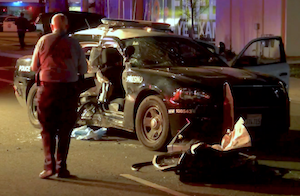
The Fresno Police Department car that was broadsided on the way to arrest a man who aimed a laser pointer at an FPD helicopter. Two officers were seriously injured. Photo from YourCentralValley.com.
When officers finally reached Quenga’s home, they found he was listening to police department radio traffic. He said “he could hear everything the officers were saying and knew they were looking for him and [he] had possibly hidden the laser.” Quenga claimed the laser beam came from a house behind him. He further said he worked as a security guard and knew he could lose his job for misuse of a laser.
US: UPDATED - 3 pilots go for eye treatment after multiple LaGuardia laser illuminations
On the evening of March 9, the Federal Aviation Administration notified the New York Police Department aviation department that someone was pointing laser beams at aircraft landing and taking off from LaGuardia Airport. A helicopter was dispatched to try and “draw fire.” Nothing happened for about 20 minutes, until the helicopter flew a path similar to an aircraft landing approach. On the second pass, a laser was aimed at the helicopter.
Both pilots were hit. Said one, “You feel a strong tingle in your eyes. You have a burnt spot where you can’t see. It is very dangerous for any pilot to be blinded.”
Ground officers went to the apartment of Frank Egan, 36. His mother invited the officers inside, where they found a device labeled “Laser 303.” According to police, Egan admitted using the laser pointer. He said it was purchased for $50 in an Orlando shop while on vacation.
He was charged with assault on a police officer, felony assault, menacing a police officer, reckless endangerment, and criminal possession of a weapon.
The next day, March 10, Egan told reporters that he did not aim the beam and that he was sleeping at the time of the incident.
From NBC 4 New York, the New York Post and the New York Times
UPDATED March 14 2015: Frank Egan’s roommate and brother-in-law, Elehecer Balaguer, 54, claimed that he was the one using the laser pointer. According to the New York Times, Balaguer swore an oath in New York State Supreme Court on March 13 2015 that he, not Egan, was responsible: “Frank had nothing to do with it. I was the one that did it. It was just a kid thing. It was a stupid thing to do.” Balaguer first denied aiming at aircraft, then after being asked two more times, confessed “I pointed it at the plane, yes, thinking it was a …” and his voice trailed off. He then said “But I didn’t mean to hurt anybody.” According to Egan’s lawyer, Egan never told the police he used the laser, contrary to the police statement after Egan’s arrest. From the New York Times. A related article in the New York Times published March 12 2015 was entitled “Powerful Lasers Easy to Buy, Experts Say.” The New York Post called the laser “military-grade” and said it had been purchased while on vacation in Orlando.
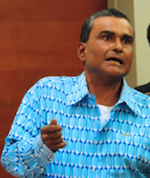
Elehecer Balaguer in court
UPDATED March 17 2015: Balaguer was charged on March 16 2015 in federal court with aiming a laser pointer at an aircraft. This has a maximum penalty of five years in prison and a $250,000 fine. FAA officials said they had to redirect traffic in and out of LaGuardia on March 9 to avoid going over the Bronx, where Balaguer and Egan lived. Balaguer’s attorney said the suspect “uses methadone every day and takes medication for bipolar disorder”, and that he was “harmless”: “It was stupidity, not venality.” From the Wall Street Journal.
UPDATED May 5 2015: Balaguer pleaded guilty in U.S. District Court to aiming a laser pointer at an aircraft. He could face up to five years in prison. The judge said sentencing guidelines call for between 2 and 2 1/2 years. He said sentencing of Balauger would not be routine “Given his psychiatric history, given his apparent lack of any wrongful intent, I can see one set of arguments being made; on the other hand I can see a different set of arguments because of the danger presented,” said the judge. Sentencing was scheduled for September 9 2015. According to the New York Post, Balaguer is a disabled ex-heroin dealer who has a history of schizophrenia and left school after ninth grade. From CBS New York, the New York Post, and the New York Times.
UPDATED April 19 2019: Frank Egan received a $227,500 settlement from New York City. His lawsuit said police had falsely claimed that Egan had admitted to owning the laser found during the arrest. Egan said his picture was widely spread in the media, his reputation had suffered, and his wedding and honeymoon were disrupted by the arrest. A Law Department spokesman said "…it was in the city's best interest to settle this case." From the New York Daily News.
US: Allegiant pilot goes to hospital after New Year's Day laser strike
The aircraft’s scheduled 8:30 departure for Los Angeles was delayed until the next morning.
A passenger on the plane said an announcement was made that the laser strike occurred as the plane was passing over the Siskiyou Pass just north of the California-Oregon border. Passengers were told it was an attempt “to cause laser blindness and potentially cause a crash.”
From KOBI5 News, Ashland Daily Tidings, and Ars Technica
Australia: "Slight eye pain" for crew of helicopter targeted by teen
It is alleged the man targeted a Seahawk helicopter from 816 Squadron as it was returning to HMAS Albatross after a training flight about 10.30pm. The high-powered laser was pointed at the aircraft for around a minute from the car park of the man’s workplace at South Nowra.
The helicopter landed safely, with the four crew members on board treated for slight eye pain.
Police from the Shoalhaven Local Area Command interviewed the pilot and co-pilot, who provided an approximate location of the beam’s origin. Police searched the area and located the 19-year-old man.
A laser pointer was seized by police and the man was issued with a future court attendance notice and is due to appear in Nowra Local Court on November 19.
From the South Coast Register
Canada: UPDATED - Pilots suffer itching, irritation from laser strike while landing in Ottawa
The incident occurred September 23 2014. The laser was pointed at the plane for around 2-4 minutes. Police are looking for the perpetrator.
Earlier in the month, on September 5, a Porter Airlines flight from Toronto was flashed with a green laser as it approached the Ottawa runway, according to CBC News.
A WestJet spokesperson said the pilots were cleared to fly and there was no permanent damage: “... there are real health repercussions for being exposed to a laser beam, so we do have a protocol in place where they will get checked out and there is also follow-ups.”
Click to read more...
US: Florida man, 52, arrested; helicopter noise bothered him so he aimed a laser at it
James McDonald told arresting officers that the noise had been bothering him. He apologized, saying that he did not know that pointing a laser at an aircraft was illegal.
He was charged with pointing a laser light at a pilot, which is a third-degree felony in Florida.
From the Sun Sentinel
Canada: Medical helicopter lased twice over Ottawa
There were no reports of the laser’s effect immediately available.
According to the Ottawa Citizen, “a similar 2009 lasing incident left an Ornge pilot with serious eye damage and grounded for several weeks after he was hit by a laser beam while flying at about 2,000 feet over the Gatineau Hills.”
Statistics from Transport Canada list 461 reported laser incidents in 2013 -- an increase from the 357 reported in 2012. The Air Canada Pilots’ Association has asked for criminal penalties and more government control over laser devices.
From the Ottawa Citizen
US: UPDATED - Guilty plea for Fresno man who aimed 50 times at CHP airplane
David Walter Fee, 22, was charged with aiming a powerful green laser pointer at Air 43, a CHP aircraft. The pilot suffered temporary blindness and the aircraft was forced to break away from investigating a burglary in progress. Also charged along with Fee was Andrew Zarate, 20, also of Fresno. The disposition of his case is not known.
Fee faces up to five years in prison and up to $250,000 in fines when sentenced.
The case was investigated by the FBI’s Fresno Office, California Highway Patrol, and Fresno Police Department. Assistant U.S. Attorneys Karen A. Escobar and Michael G. Tierney prosecuted the case.
From the Fresno Bee and the April 10 2014 U.S. Attorney’s Office press release about the indictment of Fee and Zarate.
UPDATED August 11 2014 - Zarate pleaded guilty to aiming a laser pointer at a California Highway Patrol airplane. He was scheduled to be sentenced November 3 2014. Fee pleaded guilty to the same offense in June and was scheduled to be sentenced August 25 2014. From an August 11 2014 U.S. Attorney’s Office press release about Zarate’s guilty plea.
UPDATED September 29 2014 - Fee was sentenced to 18 months in prison, plus two years of supervised release. From KMJ Now.
UPDATED November 3 2014 - Zarate was sentenced to one year in prison, plus two years of supervised release. From Ars Technica and ABC30.
US: FBI searching for laser perpetrator after Delta pilot's vision "severely disrupted" on landing an NY LaGuardia Airport
The FBI announced on March 28 that they were searching for suspects in the Queens Boulevard area of Elmhurst, Queens, New York City. The bureau’s Joint Terrorism Task Force offered a $10,000 reward for information leading to the arrest of the perpetrator.
From the Associated Press via MassLive.com, and Queens Chronicle. This incident was widely reported as an injury to the pilot, in press headlines such as “FBI: Laser flashed at Delta cockpit injured pilot landing airplane at New York’s LaGuardia Airport”
US: Dallas medic in helicopter suffers eye injury from laser on ground
Michael Pruitt, 30, was heading to St. Paul University Hospital in Dallas with a patient when a laser was aimed from the area of Interstate 35 and Harry Hines Boulevard. Pruitt was struck in the right eye.
The helicopter made an unplanned landing at Dallas Love Field. The patient, Pruitt, and the flight nurse rose in an ambulance to the hospital, a distance of about 2 miles. At the hospital, Pruitt’s eye injury was examined.
A Dallas Police Department incident report says Pruitt sustained “a burn to his right eye” and was “unable to see out of it.”
A spokesman for his employer, Air Evac Lifeteam, said “Its my understanding he’s fine.” But Pruitt’s father said his son still cannot see out of his eye and has a headache: “We think his eye will be fine, but you never know until it heals. He’s been in a lot of pain.”
An FAA spokesperson said this was “the most significant injury we’ve seen in the DFW area.”
From NBCDFW.com and WFAA.com
UK: Pilot relates trying to land airplane in bad weather plus a laser strike
The unnamed pilot was on approach to Newcastle International Airport. He told the Eastern Chronicle:
The weather was atrocious, with strong turbulence and crosswinds outside of the legal limits for my first officer. The aircraft was being battered by the gales and the landing conditions at the airport at the very margins required total concentration from the flight crews, and in particular, myself as the captain landing the aircraft with a large number of passengers inbound from the Mediterranean.”
He was then hit in the left eye, with a “searing pain”. He turned towards the light, looking at the source.
“My left eye was left sore and blurred but, mercifully, weather conditions eased and the landing was uneventful. On this occasion it was just a major distraction on a very difficult night when all my efforts should have been on getting the aircraft safely down.
“Had the attack happened minutes later, both eyes would have been affected and my co-pilot would have had to face the prospect of landing outside his limits, or diverting. The miscreant must have been very aware of the conditions and its only aim was to bring down the aircraft and its occupants.”
From the ChronicleLive and the Telegraph
US: One JetBlue pilot has migraines, short-term damage from Palm Beach laser exposure
Two days later, one of the pilots’ doctor said the aviator is experiencing migraines and “short-term damage” and has been forced to take the week off. Dr. Marc Brockman of the Florida Vision Institute said there will not be long-term damage. He noted that “If this were an industrial laser, it only takes a split second [to do damage]. The doctor also said the laser perpetrator’s aim does not have to be accurate because the eye is naturally drawn to bright lights.
From WPTV.com
US: UPDATED - News reports quote helicopter pilot who suffered two burned corneas from 1995 laser exposure
Reporter Jim Avila: “We also spoke to helicopter pilot Steve Robertson who suffered two burned corneas from a laser attack.”
Robertson: “You take the vision out from a pilot, that aircraft’s ability to land is greatly compromised.”
A Google search turned up three stories about Robertson’s injury. A November 2010 Glendale News-Press article included the following:
Glendale Police Sgt. Steve Robertson is all too familiar with the consequences of pointing a laser at a helicopter.
Robertson's corneas were severely burned 15 years ago when his police helicopter was flashed with lasers. He said it felt similar to being hit by a baseball bat.
"It's no different than pointing a gun or shooting at a police officer," he said. "It could have the same outcome."
Robertson said he avoided crashing because he was flying with another pilot.
After being struck by the laser, Robertson was taken to a nearby hospital, where doctors scraped his corneas. He returned to work four days later and still has 20/20 vision, he said.
Robertson's injury was the last laser-related injury to the department's helicopter pilots.
A January 2011 NPR report also has information about the incident and injury:
Glendale Police Sgt. Steve Robertson remembers the first time he encountered a laser strike. He says his helicopter was hit by a powerful beam of green light one night while he was on patrol.
"It immediately [lit] up the whole cockpit and it hit both of my eyes and burned both of my corneas," says the veteran pilot. "Instantly, I was blinded. It felt like I was hit in the face with a baseball bat — just an intense, burning pain."
Robertson was momentarily incapacitated and would have crashed if his co-pilot hadn't been able to land the chopper. He recovered from his injuries. But since that incident back in the mid '90s, Robertson says he and his fellow police pilots in Glendale have been targeted dozens of times by people shining cheap, easy-to-buy lasers.
Sources: Dec. 10 2013 video report from ABC News. Nov. 2010 story from the Glendale News-Press. Jan. 2011 story from NPR. Not quoted above is a Feb. 2013 ABC News story; it may have used the same interview clip as the Dec. 2013 ABC News story.
UPDATED JUNE 20 2014: Another story referencing Robertson’s claim of two burned corneas is from CBS Los Angeles on June 19 2014.
Malta: "Semi-pro" astronomer argues in court that laser pointing is not hazardous
In court in early October, David Camilleri of Rabat was described as a “semi-professional astronomer” who was aiming at stars. He said airplanes were not his target. Camilleri’s lawyer said the case was “being blown out of proportion.” He argued that if lasers were capable of bringing down aircraft, terrorists would use them to cause crashes. He also noted that footballer Lionel Messi was able to score despite having 10 lasers pointed at him during a match.
The trial is ongoing as of October 4 2013, so the outcome is not yet known.
From the Malta Independent
US: UPDATED - Man arrested in San Diego, police helicopter pilot is "recovering"
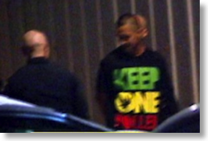
The name of the suspect was not immediately provided.
From U-T San Diego and CBS8.com
UPDATED September 19 2013: The man arrested was identified as Abel Becerril. A news story from ABC 10 includes video from the ABLE helicopter. There were two men in a parking lot, who hit the helicopter more than seven times. They then separately ran away, tossing the laser pointer during their run. Becerril will be charged with a felony. According to San Diego police, laserings of their helicopter happen “several times a week.” From ABC 10news.com (story, video and still photo shown below).
Russia: Laser aimed at passenger jet landing at Moscow airport
The pilot of the Tupolev Tu-204 jet, bound from the city of Krasnodar in south Russia to Moscow, said he was blinded by the beam as the plane was approaching Vnukovo Airport. The plane landed normally; all 220 passengers and 8 crew were unhurt. An investigation is underway.
A similar illumination occurred on August 24 2013, to an airplane on approach to Pulkovo-1 airport in St. Petersburg, according to a UPI report.
Click to read more...
Canada: Teen arrested in Calgary for temporarily blinding police pilot with laser
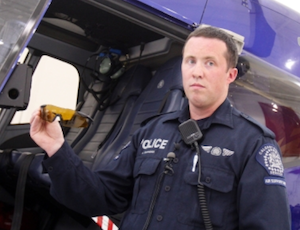
A Calgary police officer holds up protective glasses of the type used by air crews to protect from laser pointers and other bright lights
During the incident, the pilot put on protective eyewear specifically designed for laser incidents. The tactical flight officer was said to have “extreme anxiety” and was temporarily flashblinded during the incident. Afterwards he had “spotty blindness and a minor headache.” Police said the Class 3 laser was capable of causing permanent blindness and burning skin.
US: UPDATED - Virginia police pilot has temporary pain from laser beam; man arrested
The pilot continued to fly in the area, to locate the laser, and was illuminated again. Farr was arrested by officers on the ground after a search of about 45 minutes.

Matthew L. Farr
Police said the laser was “ten times more powerful than the average store bought device.” [Assuming store laser pointers are below the FDA limit of 5 mW, that would put Farr’s laser at 50 mW. The beam from such a laser would cause visual interference at distances 3.16 times greater than a 5 mW pointer.]
WTVR spoke to Farr, who admitted shining the laser “only briefly” and said he was surprised “when the cavalry arrived” at his home.
If convicted on the misdemeanor, Farr could face up to a year in jail and up to a $2,500 fine. Federal charges could also be filed.
From NBC12.com, WTVR CBS 6, and the Washington Post
UPDATED September 3 2013: Farr died in an automobile accident at around 2:30 am on September 2 2013. His SUV went off the road and hit a tree on a road near his home. More information is here.
US: UPDATED - 2 years probation in May 2012 St. Louis helicopter lasing
On May 18 2012, Michael Brandon Smith, then 35 years old, aimed a green laser beam at a St. Louis Metro Air Support helicopter that was investigating a burglary. The beam illuminated the cockpit several times. The vision of the pilot and observer was affected; the observer later said he had short-term vision problems. Ground units arrested Smith -- still with the laser in his hand -- at his residence in O’Fallon, Missouri. The incident diverted the helicopter from the burglary investigation.
Smith pleaded guilty in federal court in November 2012 to one felony count of aiming the beam of a laser pointer at an aircraft.
From STLtoday.com and The Republic. The story was originally briefly reported in LaserPointerSafety.com.
UK: Laser "injury" reported to Manton helicopter pilot
Police are seeking information about the incident.
From the Trader & Guardian
US: Coast Guard crew member goes to hospital after laser hits executive jet
The crew member was treated for temporary vision impairment and will make a full recovery.
According to the Coast Guard, this was the third laser incident since June 2012 for aircrews at Coast Guard Air Station Corpus Christi. A Navy air station nearby has reported two other incidents.
From KTRK-TV 13 Houston, CNN and Caller.com
Australia: $20,000 fine for Perth-area couple who aimed laser at police helicopter
On July 20 2012, the Polair 61 helicopter was patrolling when it was hit by the laser beam. The pilot took evasive action. The crew was able to identify the source. Ground crews arrested 29-year-old Patricia Giguere and 31-year-old Clemens Trauttmansdorff. They first denied having a laser, then eventually surrendered to police.

Patricia Giguere demonstrates how she aimed the laser from her porch
In an interview, Giguere said she and Trauttmansdorff had bought the laser in Bali. They did not think the beam could reach the helicopter. Giguere was in Australia on a partner provisional visa. She said the conviction could jeopardize her chances of staying in the country.
News reports gave conflicting information on the frequency of laser incidents in the area. A Police Air Wing pilot said “laser attacks took place at least twice a week, and sometimes up to five times a night.” However, the Rockingham Police officer-in-charge said laser incidents “don’t happen very often.”
From the West Australian and InMyCommunity.com
US: Phoenix man gets 90 days in jail for lasing three aircraft

90 days in jail for Michael Cerise
The lasings happened on November 9 2011. A U.S. Airways flight carrying about 200 passengers altered its course by 90 degrees during final approach, to avoid the laser. A Frontier Airlines flight carrying about 130 passengers was also illuminated. A Phoenix Police Department helicopter sent to investigate was hit as well.
Cerise was found at his home with a laser hidden in his couch cushions. At first he said he had not pointed lasers at the sky, but in a later interview said he had aimed it upwards to test its distance capabilities.
Three pilots had temporary partial blindness due to the laser light. Authorities said there had been similar incidents in the area for eight months prior to Cerise’s arrest.
From CBS5, AZCentral.com and East Valley Tribune.
US: JetBlue pilot reports minor laser injury over Long Island
The First Officer was in command of the aircraft when two flashes of green laser light came into the cockpit, about 10 minutes before the plane landed safely at JFK. After landing, he went to a local hospital for an examination. Apparently, no other person on the flight was adversely affected by the laser light.
The FAA and FBI are investigating the incident.

Flight path of JetBlue Flight 657 on July 15 2012, from FlightAware
From myfoxny.com, NYCAviation.com, NBC 4 New York, and ABC News.
Commentary from LaserPointerSafety.com: The FAA defines a laser eye “injury” as anything which happens to an eye, including temporary afterimages and watering eyes. According to this definition, around 1.5% of all laser illuminations of aircraft result in an eye “injury”. In 2011 there were 55 FAA-reported “injuries” out of 3,191 total laser incidents. From Jan 1 to June 28 2012, there were 20 “injuries” out of 1,519 incidents.
Almost all of what FAA calls “injuries” are in fact normal eye effects resulting from bright light exposure. For example, a person temporarily flashblinded by a camera’s flash would be “injured” according to FAA, although eye safety experts clearly state that an afterimage is temporary bleaching of photoreceptors and is not an injury.
Using a scientific definition of visible laser eye injury, meaning a minimally visible lesion on the retina, there have been no documented permanent laser eye injuries to pilots in any of the over 11,000 FAA laser incidents on record. This is according to FAA’s top laser/aviation safety expert. There have been roughly 3-5 temporary laser eye injuries where pilots had a lesion which was medically visible, and which subsequently healed to leave no spots or other adverse vision effect.
This is not to discount any eye effect or distraction of pilots -- aiming lasers at aircraft is a crime and a serious safety issue. But FAA should be more accurate, and give additional information, when providing information about pilot eyes affected by laser light.
.
US: UPDATED - 100-year sentence possible for Va. man after two laser incidents
- Two counts of interference with flight crew (20 years maximum penalty for each count)
- Two counts of aiming a laser pointer at an aircraft (5 years maximum penalty for each count)
- Two counts of assaulting, resisting or impeding federal officers (25 years maximum penalty for each count)
The Virginian-Pilot reported that Bruce aimed lasers at the jets “more than a dozen times” since December 2011. He was annoyed by the their noise. The two counts of assaulting federal officers may be related to Bruce calling the air station to threaten to shoot at the noisy aircraft.
According to a press release, “it is believed that the Eastern District of Virginia is the second jurisdiction to indict” using the new Federal law passed February 14 2012, making it a criminal offense to aim a laser pointer at or near an aircraft.
From the U.S. Attorney’s Office press release, PilotOnline.com, and WAVY.com
UPDATE July 31 2012: Bruce pleaded guilty to one count of interfering with the operation of an aircraft. The other five counts were dropped in exchange for the guilty plea. Bruce will be sentenced October 19 2012. He could receive up to 20 years in prison and a $250,000 fine. Pilots testified that they saw lasers at least 10 times from the area of Bruce’s house between December 29 2011 and June 5 2012. One of the pilots lased by Bruce reported that direct eye exposure was painful, distracted her during landing, and gave her a headache. A spokesperson for Oceana Naval Air Station said that, of 18 laser incidents in Virginia Beach since December 2011, 12 of the incidents were due to Bruce. There were 12 incidents total in 2011. From the Virginian-Pilot.
US: Officer injured by cocaine user in Pasadena laser incident
This was the ninth laser incident reported by the Pasadena police in 2012. A police statement indicated that the helicopter crew had protective eyewear, but was not wearing them when the laser illuminated the aircraft.
After the helicopter landed at the Pasadena Heliport, the officer was taken to Huntington Memorial Hospital for evaluation. Police said the officer was “not seriously injured” and that there was no permanent damage.
From KABC, the San Gabriel Valley Tribune, and the Pasadena Sun
US: Man arrested after laser "blacks out" pilot

Jorge Garcia, charged with one count of pointing a laser light at a driver or pilot, causing injury.
The pilot suffered an eye injury, according to police. He was taken to a hospital, treated, and released.
From WINK News and WZVN-HD
.
Switzerland: CHF 7,700 fine for aiming laser at Montreaux helicopters
Since the incident, “powerful” lasers have been outlawed in Switzerland, but pilots still report incidents. The Swiss emergency rescue team Rega says lasers have been pointed at their helicopters 16 times from January to October 2011.
From World Radio Switzerland. The original October 2010 story of the arrest and crew injuries is here.
US: Helicopter pilot describes laser effects
No one has yet been caught in the incident, which took place over Terrell, Texas which is about 30 miles east of Dallas.
From NBCDFW.com
US: 18 months in Philadelphia helicopter incident
According to press reports, it is unclear if the man, Lenny Tavarez, knew that the laser could cause a crash. Tavarez was 19, and a recent high school graduate with no criminal record, when the October 2008 incident occurred. He was sentenced May 13 2011.
From Philly.com. A report of the original 2008 incident is at ABC 6.
US: UPDATED - Helicopter pilots injured in Florida laser incident
19-year old Hidalgo Moreno and 17-year-old Nicholas Ramos were arrested in North Naples and were charged with “pointing a laser light at a vehicle or aircraft operator causing injury” a Florida felony with up to a five-year prison sentence, according to the Naples Daily News. The teens told deputies “they didn’t realize it was not legal to point a laser at the helicopter and they were just playing with it.”Click to read more...
Canada: Pilot suffers retinal damage; off work for months
It was not clear from the story what type of aircraft -- fixed wing or helicopter -- the pilot was flying at the time.
Captain Barry Wiszniowski of the Air Canada Pilots Association, stated "Our judicial system has to understand the severity of the consequences. It would be catastrophic if a pilot was impaired by a laser and lost all situational awareness."
More statistics and information from Canadian OH&S News.
Bosnia: US helicopters hit four times by lasers; caused eye injuries
Intro: The pilot and a crewman on an American helicopter were hurt recently (October 24 1998) when someone fired a laser at their aircraft patrolling over Bosnia-Herzegovina. The men were able to land safely but this, and similar incidents in the Balkans, have sparked concern among U.S. air crews. U.S. military officials and police in Bosnia are investigating the incidents, and the U.S. Army says it is now changing the way it uses its helicopters. VOA's Jim Randle reports from the Pentagon.
Text: Pentagon officials say U.S. helicopters have been hit by lasers four times in Bosnia. Officials say one case caused 'mild to moderate' eye injuries when the laser light stayed on the aircraft for four or five seconds. The pilot and a sergeant were both treated for eye injuries, and both are expected to recover and be able to resume flying.
Nevertheless, Pentagon officials say the Army is changing the way It uses helicopters over Bosnia to lessen the danger to pilots -- but will give few details.
Pentagon spokesman Mike Doubleday did say pilots now have some protection from the laser threat: "What we've done to deal with the situation is to provide helicopter crews with either special glasses or goggles that protect their eyes in these situations."
An expert in weapons technology says the pilots have good reason for concern. John Pike studies strategic issues for the Federation of American Scientists. He says four thousand Iranian soldiers suffered eye injuries, including blindness, when Iraqi forces swept powerful lasers across their ranks during the Iran-Iraq War.
Mr. Pike said, "It was a lot easier for them to injure those soldiers using a laser than it was to kill them by hitting them with a bullet. And the thing is that an injured soldier is a lot more of a burden to a military than a dead soldier is, because every injured soldier requires several more to get him back to the hospital."
Mr. Pike says the Iranian battlefield lasers were those used by tanks to determine the range to a target. Other lasers are used to guide bombs and shells to targets with great precision.
Lasers are used by many nations, including the United States, in tanks, anti-aircraft weapons and to disrupt electronic devices.
Mr. Pike says recent treaties [the Protocol on Blinding Laser Weapons, a 1995 amendment to the 1980 Geneva Convention on Certain Conventional Weapons] labeled weapons specifically designed to blind soldiers as "inhumane" and banned their use. But he says with so many lasers playing so many battlefield roles, it will be difficult to enforce the ban on these weapons.
From the Federation of American Scientists
US: DOD confirms eye injury to copter passenger; perhaps from Russian vessel Kapitan Man?
Coast Guard and Navy personnel boarded the vessel on April 7 but were unable to find any laser device, or evidence of a possible device. U.S. Navy Lt. Cmdr. Jack Daly was then examined by military laser eye injury experts, who found “there was a high probability that the minor burns on the lieutenant's right retina were caused by multiple laser exposures such as might result from a single glimpse at a repetitive pulsed laser.”
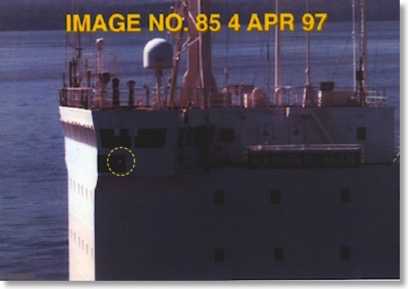
The American naval officer took this photo in the Strait of Juan de Fuca showing a red light on the M/V Kapitan Man. The light led some to suspect a laser. However, subsequent inspection did not find a laser, and in the location of the red light were “two deep red running lights … that met the guidelines established for sidelights.”
The U.S. Defense Department concluded that “[a]vailable evidence does not indicate…what the source of such an exposure might have been. Specifically, there is no physical evidence tying the eye injury of the American officer to a laser located on the Russian merchant vessel.”
The Strait of Juan de Fuca laser incident was also discussed in the August 2004 medical journal Archives of Ophthalmology. The article “Assessment of Alleged Retinal Laser Injuries” describes “Case 5” and concludes that “…[n]o evidence of laser injury was found in the years after the incident by 17 other ophthalmologists, including 5 neuro-ophthalmalogists and 8 retina specialists. A trial was held 5 years after the incident in which the retina specialist who made the initial diagnosis steadfastly maintained all the photographer’s [naval officer’s] symptoms were due to retinal laser injury. A jury ruled against the photographer’s claim for damages against the ship’s owner.… The patient had real complaints, but they were caused by preexisting autoimmune problems rather than by laser injury.”
The full text of the DOD press release, and the “Case 5” study is below (click the “Read More…” link). Additional information above is from a 2011 Washington Times story.
US: Military says Soviet ship aimed laser at US aircraft; injuring pilot's eyes
The incident happened September 30 or October 1, 1987. According to an October 2 1987 Pentagon statement, a U.S. Navy P-3 reconnaissance aircraft was “illuminated by an intense light” from the Soviet ship Chukotka. An Air Force WC-135 intelligence plane also was illuminated.
The statement said the light “disturbed” the vision of the co-pilot, and “although preliminary medical evaluation has shown no apparent damage, further detailed tests may be required to determine if, in fact, no damage to her eyes occurred.”
Sen. Malcolm Wallop (R-Wy) initially disclosed the incident. He said “In my opinion, anything that disturbs your vision for 10 minutes damages your vision. The effect was to temporarily blind that co-pilot."
According to the Pentagon, they believe the light source was a laser. The Pentagon statement did not speculate on the reason for the illumination of the aircraft.
The New York Times referenced one official who said the Soviet ship might have tried to harass or blind the pilots, while a naval consultant said it could be that the laser was used to track missiles and was inadvertently shined at the U.S. aircraft.
Such illumination had occurred before, according to the Pentagon statement.
The 1987 edition of a Pentagon publication, Soviet Military Power, said that "recent Soviet irradiation of Free World manned surveillance aircraft and ships could have caused serious eye damage to observers." The following picture and caption appeared on page 113 in the book:
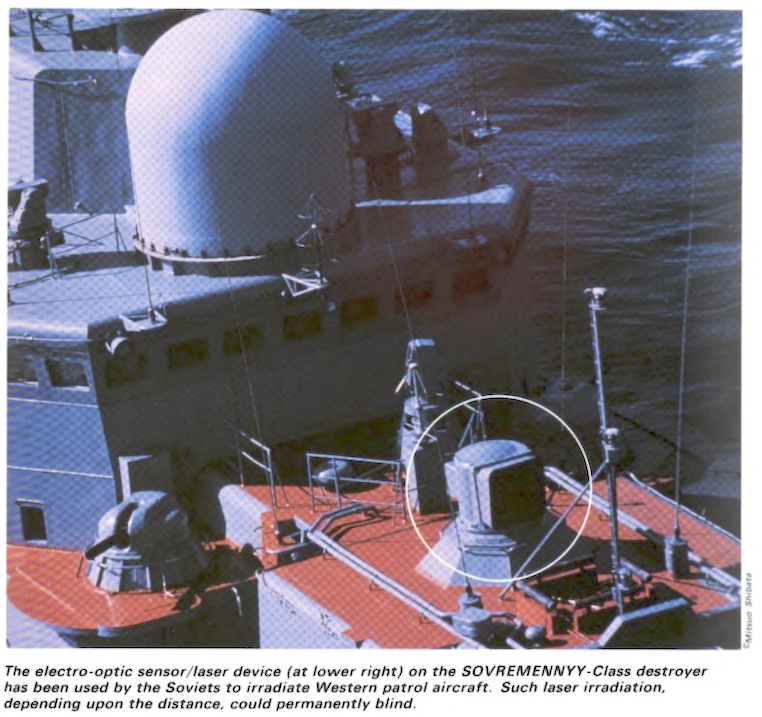
From the New York Times and the Los Angeles Times
